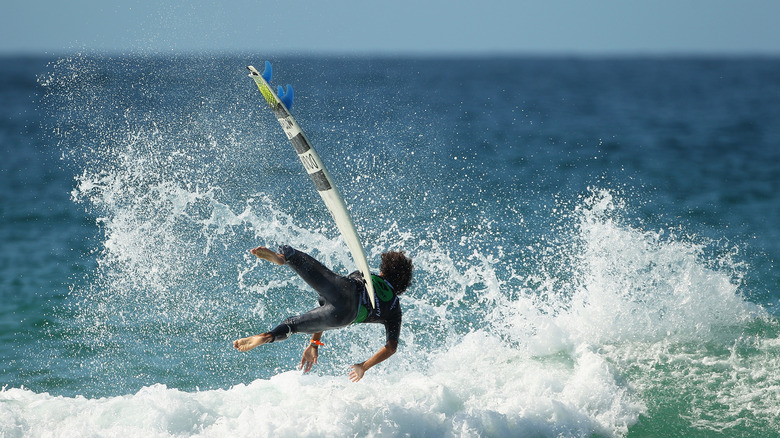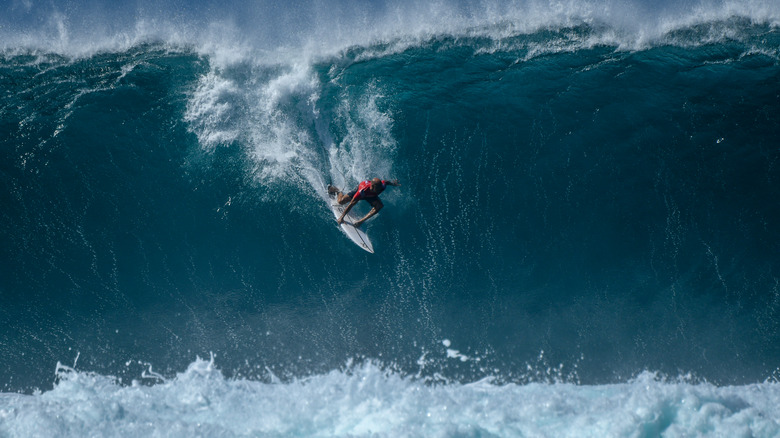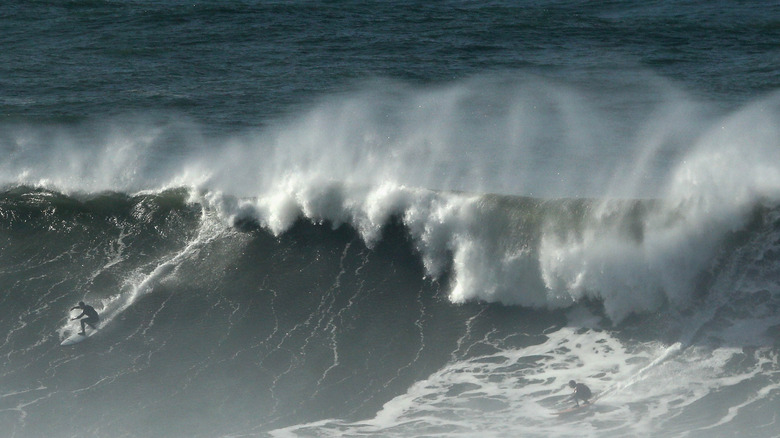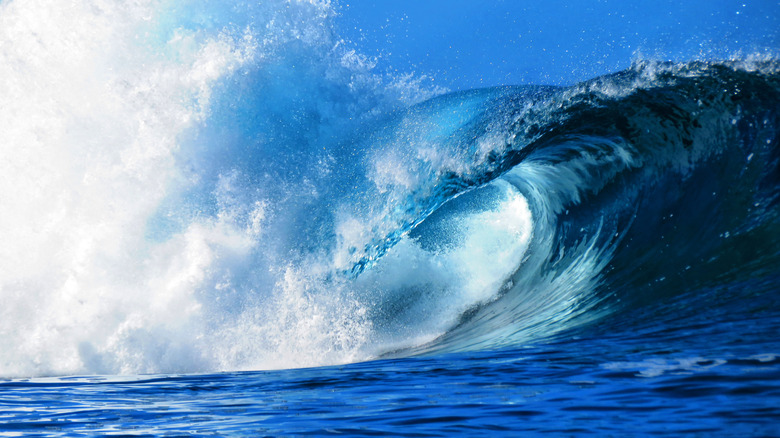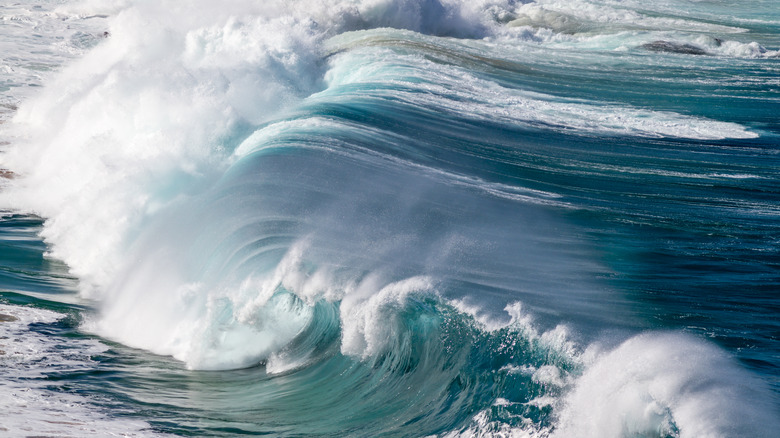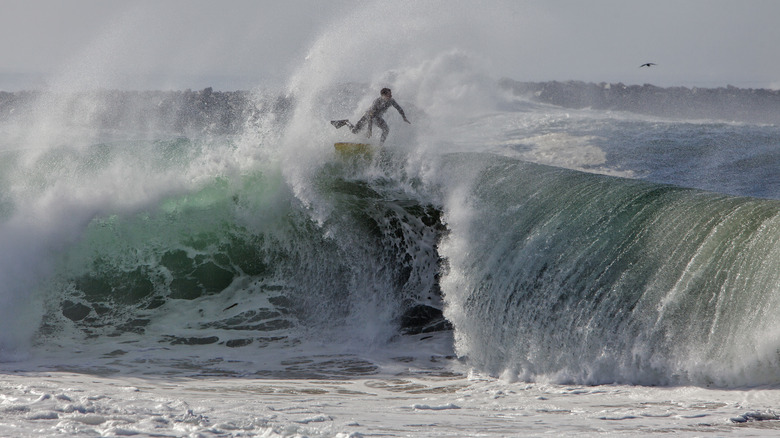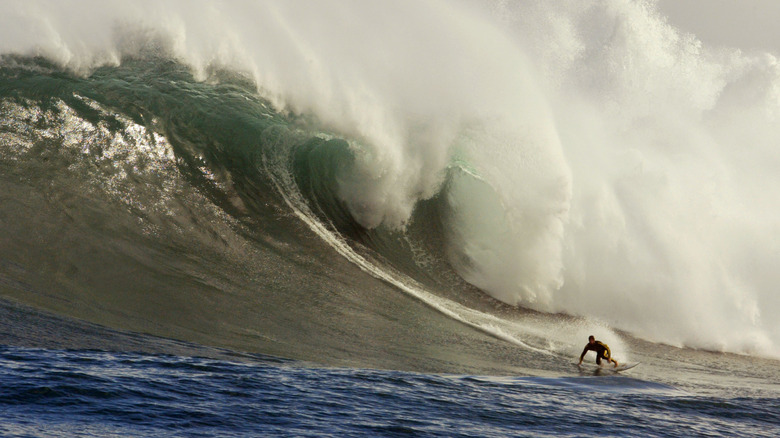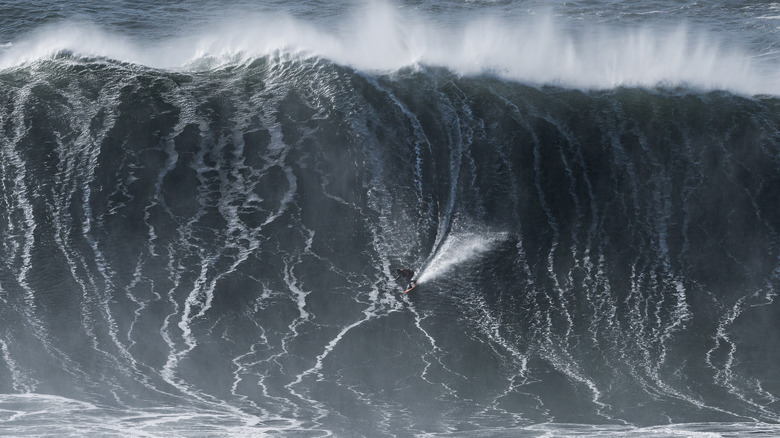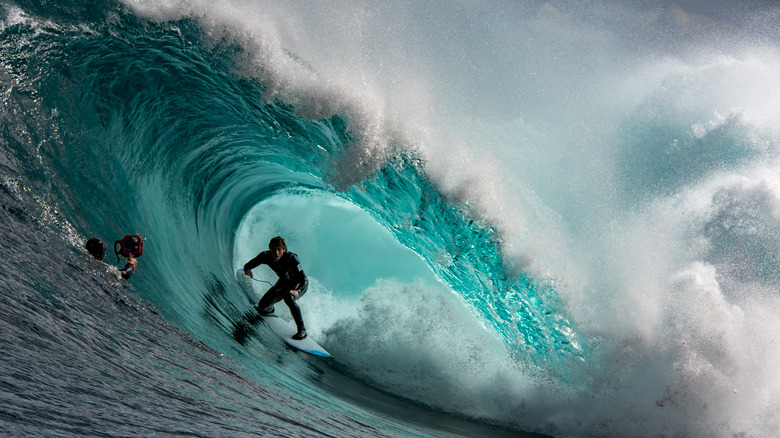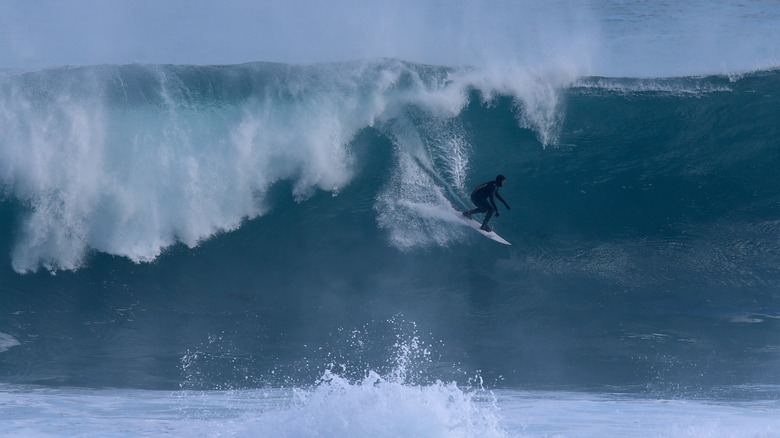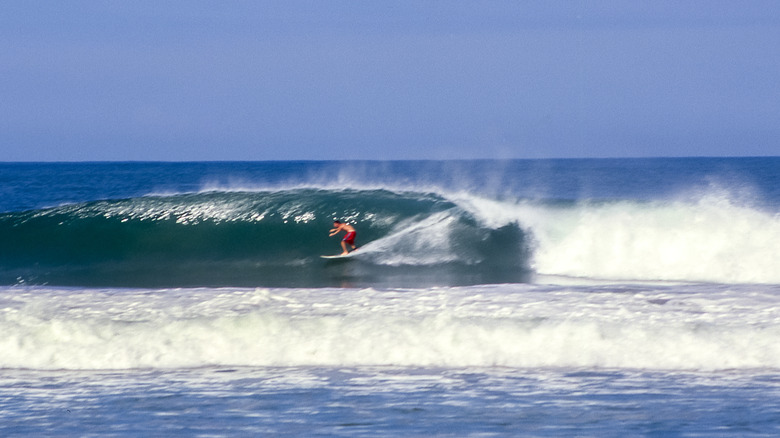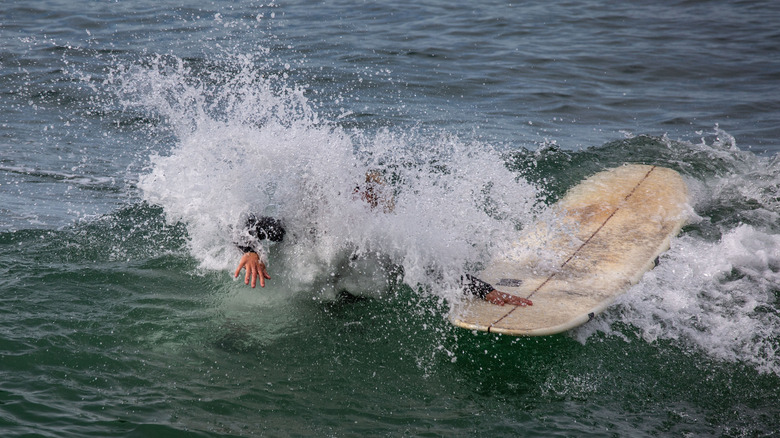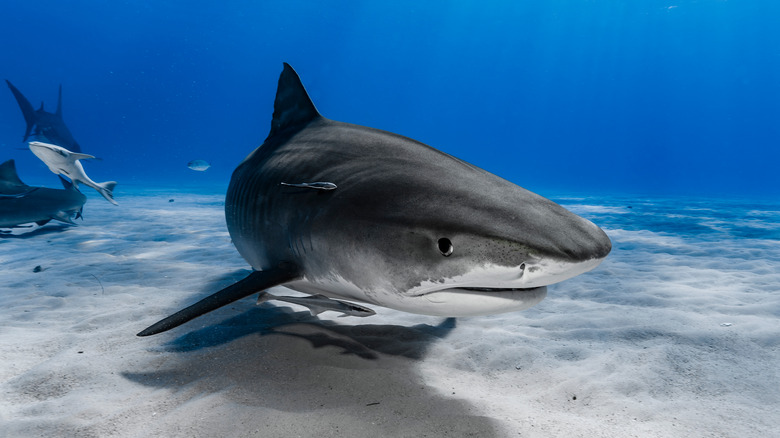The Deadliest Surfing Spots In The World
Surfing is a beautiful, technically tricky, and dangerous sport. To put it in surfer lingo, it isn't for the Barneys who get sucked into the soup (translation: rookies who routinely get dunked into the foamy water after a wave break). The good news is, on the whole, surfing is safer than skiing and presumably lion-taming. A retrospective study published in the journal Sports states that for about every 1,000 hours you spend riding the waves, you may expect between .74 to 1.79 injuries. More often than not, it is from being hit by your own board.
The bad news is that sometimes a radical wipeout leads not just to broken bones, contusions, concussions, and lacerations, but, tragically, to death. A 2018 study shows that every year, there are a handful of surfing deaths. More horrifically, sometimes you might not get killed by waves, rocks, and water, but rather because surfing in some spots is like ringing the dinner bell for sharks. It is not the statistical frequency of surfing deaths that's terrifying, but rather how spectacular surfing accidents can be.
A number of the world's most glamorous surfing spots, which draw elite surfers from near and far, have proven to be among the most deadly. Let's take a look at some. In surfer parlance, bro, if you are a fresh grom and just got your first gun, you should read this article before you hit the heavy.
Banzai Pipeline, Hawaii
On the north shore of Oahu, there is a stretch of beach home to a deadly wave called the Banzai Pipeline. The Pipeline is world famous; its gorgeous 20-foot breakers have been featured in movies such as "Blue Crush." But as stunning as the Pipeline is, it is called "Banzai," a famous Japanese battle cry, for good reasons. The waves crash over a razor-sharp reef that has led to numerous injuries and about seven reported deaths (per SFGate), though a cursory search around the web alludes to many more.
Even the best surfers are vulnerable to the fickle whims of the Pipeline. The first modern fatality at the spot occurred in 1967 when Peruvian surfer Joaquín Miró Quesada wiped out headfirst into the reef. Deaths have occurred periodically ever since. One of the most recent incidents occurred in 2020, when SurferToday reported on the death of Brazilian bodyboarder Marcus Biju. It is thought he banged his head on the reef, fell unconscious, and then drowned. However, what really happened is unknown since would-be rescuers found his body floating in the water.
Sites like SurferToday caution that the Banzai Pipeline should only be attempted by seasoned riders. The danger of surfing the Pipeline is also well-known to locals who are leery about letting outsiders try it, especially when the conditions are dangerous. For example, there was one incident in 2022 when, during rough conditions, a lifeguard leveled a profanity-laden tirade at tourist surfers who would have likely been killed if they had dared the Banzai Pipeline.
Maverick's, California
If you are a thrill seeker looking to pit your nerve against the sea, you should head over to Maverick's on the coast of California off Half Moon Bay. Maverick's, located in an isolated spot near San Francisco, is globally toasted for its big and powerful waves, which are generated by a unique combination of currents, pressure systems, and geological factors. This is awesome for surfers with T-type personalities who pish-posh at safety in order to ride some truly freakish waves of more than 50 feet when conditions are right.
Such natural power can spell trouble even for the most seasoned surfing professionals. The first recorded and most well-known death at Maverick's was that of surfing pro Mark Foo in 1994. He heard that the wave at Mavericks was going big, so he flew to California to take advantage of it. Sadly, as Foo was coming down a wave — and not even a big one, by Maverick's standards — it was too much. The surfer lost his balance, and he plummeted into the raging sea. Duke Boyd's "Legends of Surfing" gives some solace to those mourning the superstar's death by quoting him as saying, "It would be a glamorous way to go; I mean, that's how I'd like to go out." In 2011, surfer Sion Milosky, who had just been named Hawaii's "Underground Surfer of the Year," drowned while surfing Maverick's.
Teahupo'o, Tahiti
Teahupo'o on Tahiti provides a surfing spot in an idyllic tropical paradise. The island is an atoll enclosed within coral reefs, which adds to the aesthetic pleasure of surfing there. What is more, and indeed what draws surfers to Teahupo'o, is that the waves, as they break over the reef (known as "slab" in surfer parlance ), grow to incredible heights and are filled with raw power. This has proven to be a deadly combination.
A typical injury at Teahupo'o was recorded in 2023, when a wave took British big-wave surfer Tom Lowe and pitched him into the reef (per Surfer). He suffered internal bleeding, fractures, and lacerations — frankly, he was lucky to be alive. Less fortunate was local Tahitian pro surfer Briece Taerea, who in 2000 was stuck in the shallow waters when a big wave came and slammed him into the reef. Sadly, he spent two weeks in a coma before finally succumbing to his injuries.
Waimea Bay, Hawaii
The north shore of Oahu is home to some of the biggest and best waves for surfers, and some of the gnarliest and deadliest are at Waimea Bay. These 30-foot-plus beasts are born when the ocean current bangs into an offshore lava shelf. The waves pile up into some genuinely awesome big surf, creating conditions for stellar wipeouts, accidents, injury, and death. The height and speed of the waves at Waimea is such that when surfers wipe out and get caught in the foam, they may be pinned by the pressure of the water for up to a minute or more and drowned (per the University of Hawaii).
Such was the case with Californian big-wave surfer Donnie Solomon. The LA Times reported that in December 1995, he was surfing at Waimea Bay and had reportedly told a fellow rider that he caught "the biggest wave of [his] life." Solomon was paddling out again since there were signs that even bigger and better waves were coming. Unfortunately, as he was paddling over a wave it collapsed upon him and he was trapped under the water, where he drowned. Since then, Waimea has still proven to be alluring to surfers — even amateurs, who are called "kooks" by the locals. In fact, one surfer site, Beach Grit, has reported on calls by surfers to ban kooks from surfing at Waimea Bay.
The Wedge, California
Big-wave surfing seems to get most of the press, but just as exciting is bodysurfing, and the Wedge at Newport Beach on the Balboa Peninsula in California is perhaps the most exciting — and deadliest — spot to boogie board. Elliott Almond in "Surfing: Mastering Waves From Basic to Intermediate" explains that the waves at the Wedge are made so deadly through reflected action. As waves bounce off of an adjacent, 2,000-foot-long granite jetty, a second wave, almost doubled in size, is formed, which is shaped like a wedge. The wave rushes into shore at up to 30 miles per hour (per the Los Angeles Times). Interestingly, this jetty was made in the 1930s by the Army Corps of Engineers, so the Wedge is a human-made phenomenon.
This mashup of nature and human tinkering is known for breaking bones and backs, smashing teeth, and killing unwary surfers. For example, in 2009, a 50-year-old bodysurfer was hurled against the jetty and smashed to death. Then in 2014, a surfer died from injuries sustained while surfing at the Wedge. Others have been paralyzed. The Wedge, however, has still proved popular as a surfing site despite these risks, or maybe because of them.
The Dungeons, South Africa
South Africa features some killer waves, but even more deadly to surfers may be the sharks. Dungeons is located off Cape Town in Hout Bay and features some truly frightening waves at up to 50 feet (per the Guardian). So intense are these waves which come in quick succession that they can trap a surfer underwater like a lepidopterist pinning a butterfly under glass. It was, in fact, a local surfer who was held underwater by two successive waves who named this spot "Dungeons" (per SurferToday).
Another reason why Dungeons is so scary is that to catch it, you have to head out about a mile from shore for the break. Thus you really feel like you are in the middle of the ocean when you start. Even worse is that the area is known to be a breeding ground of great whites, the most dangerous shark to humans, and is considered to be shark-infested. Even though there haven't been any recorded deaths hitherto at the Dungeons, it just seems like a matter of time — seriously.
Nazaré, Portugal
Praia do Norte in Portugal, near the village of Nazaré, is home to the biggest surfing waves in the world. The Guardian reports that these extreme waves have reached up to 80 feet. Such tremendous waves can be a deadly hazard to those who would dare surf them. One of the most dramatic incidents was in 2013 when the Brazilian surfer Maya Gabeira was nearly killed. The New Zealand Herald described how Gabeira was towed to a big wave that was too fast and powerful. After several bumps, she was thrown off her board into the rushing water. She broke her ankle, then a second wave tore off her lifejacket; she was then trapped under the water, where she suffered blackouts and nearly drowned. She was eventually rescued and revived by CPR. Amazingly, Gabeira overcame the trauma and went on to surf Nazaré again in 2017 and 2020, when she set a new world record for the tallest wave surfed by a female: 73.5 feet.
Injured surfers have been a constant litany at Nazaré. The list includes Andrew Cotton, a big-time British surfer who was smashed by a Nazaré wave in 2017, breaking his back. Then there are deaths, with the most recent being the 2023 death of 47-year-old Márcio "Mad Dog" Freire, who was swamped by a big wave while practicing tow-in surfing. While he may be the first official death at Praia do Norte (per SurferToday), it seems likely that there will be more.
Shipstern Bluff, Tasmania
Tasmania, at 42 degrees south latitude, lies in the heart of the "Roaring 40s," where powerful winds and currents create daunting seas. These slam right into Tasmania, the little island south of Australia, to produce some of the meanest waves in the world. One such legendary wave is at Shipstern Bluff. Surfers who want to surf there really need to make an effort. To get to it, Douglas Booth writes in "Surfing: The Ultimate Guide," you either have take a boat or walk for a couple of hours through a nature preserve and farmland. When you get there, it is impressive — as the waves break across the reef, they may triple in size.
Because of its raw power, Shipstern Bluff is notoriously dangerous and daunting, considering there is no place you can quickly get medical help. Injuries are par for the course. Surfer reported how, in January 2023, a 19-year-old man was pummeled by the wave until his father rescued him. Then, in June of the same year, Australian surfing pro Dylan Longbottom was tossed off his board and spun about like he was a pair of old socks in a washing machine set on the spin cycle. He suffered four broken ribs and a punctured lung. So while Shipstern has thankfully not claimed a life yet, it seems to be a roll of the dice away.
Margaret River, Western Australia
In the southwest corner of Western Australia near Margaret River off Surfer's Point is a dangerous surf break called "the Box." The way the surf breaks over the reef makes for powerful and unpredictable waves. Surfing sites such as SurferToday warn that the Box is too dangerous to surf once its waves exceed 6 feet. What is more, they are so fast-moving that if you aren't positioned correctly, you are likely to be rammed headfirst into the rocks. That is why pros strongly recommend wearing a helmet.
It is for these reasons that although the waves at the Box do not reach awe-inspiring heights, the danger of death is quite real. The Australian site Tracks reported on one incident where a man was struck by a rogue surfboard. It severed his femoral artery and although he was rushed to the hospital, he died. In 2021, a veteran 65-year-old surfer died when his surfboard tether got caught in the reef (per 7News). In 2023, a man died after having a "medical episode" in the water, according the Australian Broadcasting Company.
And that's just the wave. The waters off Western Australia are known to be filled with sharks. One surfer off Margaret River was attacked by a great white shark in 2023 but managed to swim ashore nearly 2,000 feet away. Still want to go surfing?
Puerto Escondido, Mexico
In the north of Oaxaca at Puerto Escondido along the Gulf of Tehuantepec in Mexico is a wave so gnarly that surfers have called it the "Mexican Pipeline," comparing it to the famous wave in the north of Oahu (per "Encyclopedia of Surfing"). Waves grow in size due to the effects of an underwater canyon, which makes them regularly reach 15 feet or so. Because the conditions and the locale are awesome, featuring warm waters and a sandy beach, the waves at Puerto Escondido are often crowded with surfers, and many pro competitions are held there. The local economy is so dependent upon surfing that the city has installed a statue of a riding surfer.
Of the various surfing spots at Puerto Escondido, the most dangerous is Playa Zicatela, to which SurferToday attributes two deaths. Maui surfer Ron Cassidy was killed in 2007, followed by the 2010 death of Noel Robinson. In this latter case, SurferToday reported that Robinson wiped out and was lost in the water for an hour before his body was recovered. The most recent death was of Valencian surfer Óscar Serra in 2021 who, according to multiple media outlets, fell off of the top of a 6-foot wave and crashed headfirst into the sea bottom.
Ghost Trees, California
At Pescadero Point in Pebble Beach, California, the ominously nicknamed surf break Ghost Trees has proven to be one of the most dangerous in the world. According to the Surfing Handbook, an offshore canyon focuses waves so that during winter months, when conditions are just right, they can reach an unfathomable 60 feet in height.
After Ghost Trees was discovered by the surfing crowd in the 1960s, it became a popular destination. By the 21st century, tow-in surfing became popular, a form of surfing in which surfers get towed out on jet skis rather than paddling. Because of the size of the waves at Ghost Trees, this unlocked the door to the spot's popularization. But it was only a matter of time before tragedy struck.
In 2007, Monterey big-wave surfer Peter Davi, who in fact helped bring attention to Ghost Trees, paddled out among the raging waves. He then fell off his board, likely smashed his head and body against the rocks, and quickly drowned. It was a monumental tragedy since Davi was a well-known and respected surfer. Since this loss, personal watercraft have been banned within the Monterey Bay National Marine Sanctuary, since they were deemed a threat to wildlife. This, in effect, makes surfing at Ghost Trees nearly impossible since you cannot physically paddle out to this spot's immense and powerful waves. But people still try, illegally.
St. Leu, Reunion Island
The lonely French island of Réunion in the Indian Ocean is home to some of the best waves in the world. While the island features numerous surfing spots, Saint-Leu is considered one of the finest by SurferToday, though it advises to be cautious of the nearby reefs. What you should really be worried about is being an hors d'oeuvres for the sharks. Réunion is a spot that surfers might call "very sharky" — in fact, it's a hotbed for shark attacks. The publication The Inertia notes that tiger sharks and bull sharks, two of the most dangerous shark species in the world, often frequent its waters.
Surfing was generally unknown on Réunion until the 1960s. After that time shark attacks grew in frequency, culminating in a grisly, years-long spate of attacks that began in 2011, when surfer Eric Dargent had his leg bitten off at the knee. He survived, but attacks grew so frequent that authorities moved to prevent anybody from swimming or surfing. (Réunion is a beautiful tropical island, mind you.) Surfers went rogue and evaded authorities to go surfing, sharks be damned. From 2011 to 2019 there were 24 shark attacks near the island, 11 of which were fatal. (It is unclear how many of these attacks were on surfers.) However, there have been positive developments. No attack has been reported since 2019, and surfers have returned (albeit still illegally) to continue to surf at this wonderful, but shark-infested, spot.
